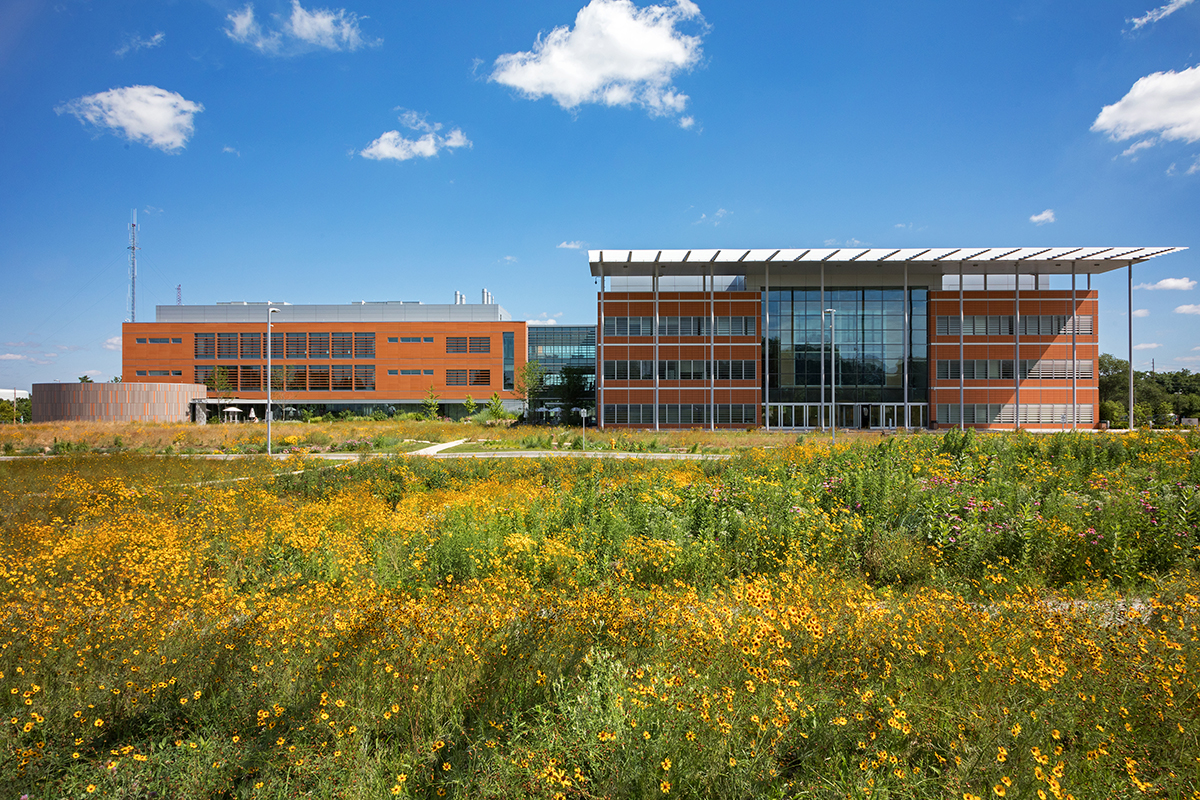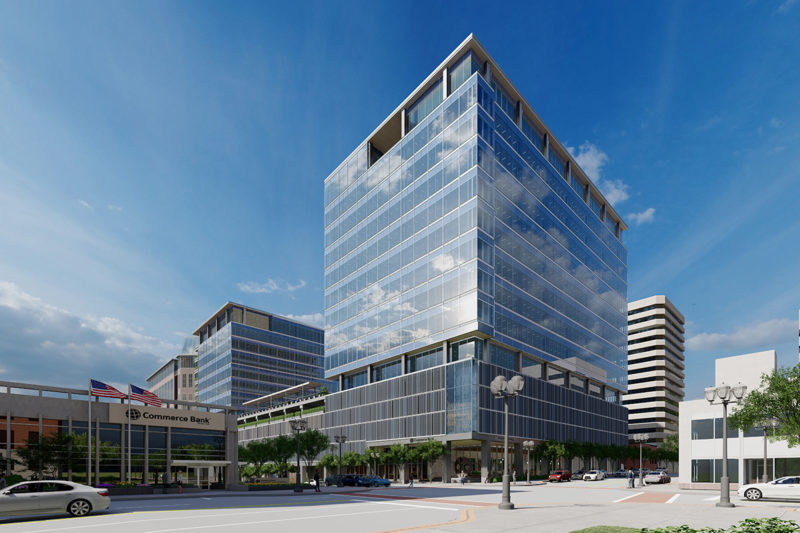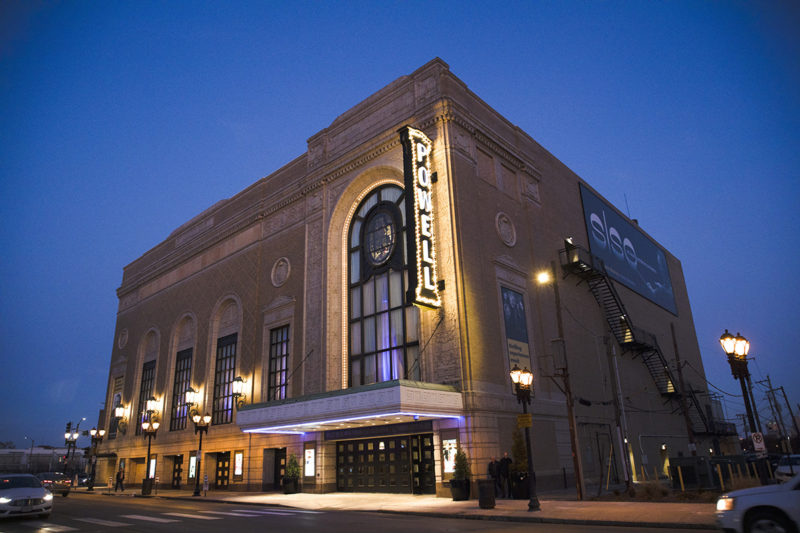In honor of National Prairie Day on June 1, 2019, Christner is celebrating the prairie at Donald Danforth Plant Science Center in Creve Coeur, Missouri. Over three acres of highly manicured turf and non-native plant species were replaced with a six-acre reconstructed Missouri Tallgrass Prairie. Starting in 2016, the prairie was sown with over 70 species of grasses and forbs including some special seed from the Shaw Nature Reserve prairies. The prairie was undertaken in conjunction with the planning, design, and construction of a 79,000-sf building addition at the Center to accommodate 120 additional scientists.

The partnership between the Danforth Center’s scientists, Missouri Botanical Garden’s Shaw Nature Reserve, and Christner’s Landscape Architects worked to transform the 40-acre Donald Danforth Plant Science Center site from a highly maintained commercial landscape to native habitats. Leaders at the Center found direct connections between their mission to “improve the human condition through plant science” and the development of native landscapes as a complement to work that goes on inside the Center – using natural diversity to improve crops and to preserve and renew the environment.
Missouri’s Prairie History
For over seven million years and before our region was settled by Europeans, one third of Missouri’s land mass, about 15 million acres, was dominated by Tallgrass Prairie. It was an ecosystem made up of a mosaic of warm-season grasses, flowering forbs, and shrubby prairie species that often grew over 6 feet tall with very few trees. Today, more than 99 percent of the original Missouri Tallgrass Prairie ecosystem is gone – only about 80,000 acres remain.

Tallgrass prairies are unique and complex ecosystems that were originally sustained by natural processes such as fire and grazing that controlled the establishment of trees and subsequent forest succession. Many prairie plants, particularly the grasses, are adapted to extreme heat, cold, drought, flooding, grazing and fire. They are plants that develop an unusually deep root system that builds rich, deep soil over time. The prairie grasses are close relatives of the crop plants corn and sorghum. Native peoples and settlers discovered that the unique properties of prairie soil could support healthy food crops. Over time, European settlement, western expansion, and large-scale commercial farming ensured that our nation’s prairie lands became the “bread basket” of the world to produce wheat, corn, and other domestic crops.
Transformational Benefits of Prairies
Today, stands of the Missouri Tallgrass Prairie can be found at Shaw Nature Reserve, Stacey Park, Dunn Ranch, public and private land, and on corporate campus sites such as the Donald Danforth Plant Scient Center. Many of Missouri’s prairies are man-made restorations that cannot perfectly replicate the natural environment of the original Missouri prairies. However, people are recognizing the prairie’s benefits in our modern world. New award-winning interpretive panels at the Danforth Center, describe the role and benefits of the prairie.
Prairies are a Carbon Sink and Soil Builder
In a significant role, prairie plants and their soil organisms help to mitigate the negative consequences of CO2 emissions by capturing and storing around 1 to 2 metric tons of carbon per acre per year below ground through the prairie’s natural role as a global carbon sink. Roots can make up 80% of the prairie plant’s total size or biomass. The largest prairie plants have fibrous roots that can extend 8 to 12 feet deep into the ground. In contrast, a standard lawn has a root depth of 2 to 6 inches, and agricultural plants like corn and wheat have root depths of 2 to 4 feet.
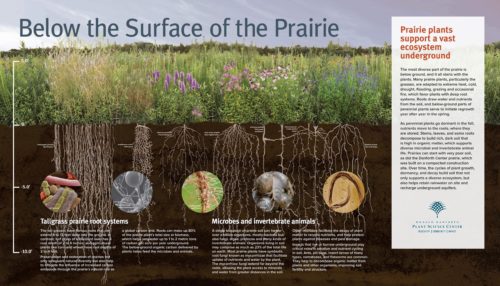
This carbon process builds soil and the dense vegetation helps keep that soil in place to prevent erosion. Prairie plants are perennial and go dormant in the fall when their nutrients move to the roots where they are stored. Stems, leaves, and some roots decompose to build soil that is high in organic matter and supports a diverse microbial and invertebrate animal life. Prairies can be established in very poor soil as was the case with the Danforth Center prairie which was sown over compacted construction soil with no topsoil on most of the site. In the first season, where the manicured grass was located on the site, the prairie quickly due to the presence of organic matter in the soil. The areas with poor soil required the typical 3-year establishment period but are now growing just as vigorously.
Prairies Capture, Store, and Cycle Storm Water
The prairie is highly effective participant the water cycle. When precipitation falls in the form of rain or snow, the water soaks into soil of the prairie. The dense prairie plant mass protects the soil from erosion and allows the time for the water to adsorb into the soil far better than in lawn or other man-made landscape. Precipitation can travel down deep into the ground to recharge aquifers or be taken up by the prairie plants. Around 95% of the water taken up by plants is returned to the atmosphere as water vapor through transpiration, contributing to formation of clouds, and subsequent precipitation.
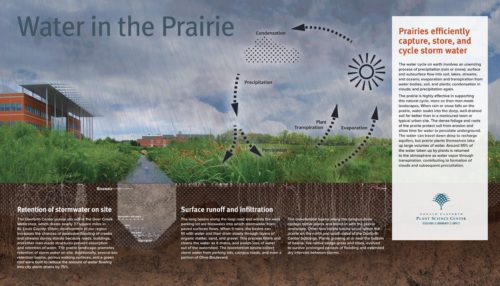
The Danforth Center prairie sits within the Deer Creek Watershed, which drains nearly 37 square miles in St. Louis County. This watershed is negatively impacted by urban development and is susceptible to excessive flooding of creeks and streams due to the density of the roads, buildings, and other man-made structures which prevent the absorption of water. On the Center’s campus, bioretention basins take in storm water from paved surfaces. When it rains, the basins fill with water and then slowly drain through layers of organic matter, sand, and gravel. This process filters and cleans the storm water before it returns to the storm sewer system. In addition, the basins are designed to highlight native plants and be an attractive landscape setting. Plants have been selected for the basins that are suited to survive the extremes – temporary flooding, wet soils, and extremely dry soils – varying conditions that occur between storms. On the Center’s campus, a combination of bioretention basins, porous walking surfaces, green roof, and prairie landscape, reduces the storm water run-off to the storm sewer system by 75%.
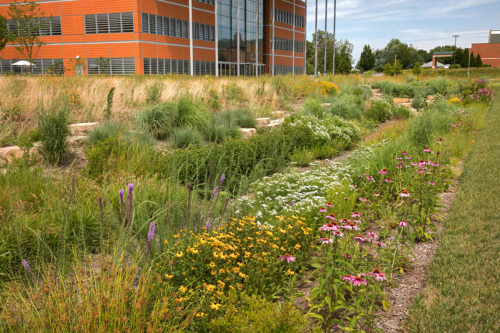
Prairies create Biodiversity and Habitat for Plants and Animals
The Danforth Center prairie is a habitat that that no longer exists in a natural form in our region. It is one of two tallgrass prairie restorations in the cities of Creve Coeur and Olivette, Missouri. The Danforth Center and the Stacey Park prairies are habitats for plant, animal, and organism biodiversity in what is otherwise a suburban landscape. A custom seed mix was developed for the Danforth Prairie from several sources, including Hamilton Native Outpost, Missouri Native Wildflowers, and the Shaw Nature Reserve. A typical native Missouri tallgrass prairie may contain over 300 plant species, with over 80% the species being warm-season grasses. The distribution of species in the prairie varies according to moisture and temperature, with certain plants becoming particularly abundant in areas where site conditions are more favorable.
With plant biodiversity, comes insect biodiversity, and animal biodiversity. At the Danforth Center, there is visible evidence of native insects and animals finding a home on campus. The animals found in reconstructed prairies in urban sites have board ranges of habitat because they can move from area to area and may not have specialized habitat-dependent needs. Today, predators such as coyotes and raptors are present at the Danforth prairie. Their presence will help keep rodent populations under control and minimize urban pest such as Canada geese.

In a healthy tallgrass prairie, there can be over 100 different kinds of ants and over 150 kinds of bees. Thousands of other insects such as butterflies, moths, beetles are the prairie pollinators that cycle nutrients, help build soil, and provide food for birds and other animals. Some animals of the prairie have habitat-dependent needs that are linked directly to the presence of particular plant species, plant community, or environmental condition found only in tallgrass prairies. Other prairie animal species needs are interconnected, thereby the impacts to one species can impact another. For example, the monarch butterfly’s existence is linked directly to the availability of the milkweed plant which provides the only food source for the butterfly and caterpillar stages of its lifecycle.
A Shout Out to Prairies
Many of Missouri’s prairies are man-made restorations that cannot perfectly replicate the natural environment of the original Missouri prairies. However, people are recognizing the reconstructed prairie’s role in promoting plant and animal biodiversity, creating habitat, supporting pollinators, sustaining migrating birds and Monarch butterflies on their flyways across the United States, and mitigating carbon emissions. The Donald Danforth Plant Science Center’s research on prairie grasses found in native landscapes focuses on plants’ ability to respond to environmental stress that can enhance cutting-edge science and technology to improve agricultural productivity. The prairie grasses also provide vital insight into how plants respond to environmental stress which can inform how agricultural crops with a lower environmental footprint can be developed.

Scott Woodbury, Curator of the Whitmire Wildflower Garden at Shaw Nature Reserve, said “…the team…has created one of, if not the most successful tallgrass prairie landscape in the St. Louis region…the prairie has graced the campus with impressive drifts of showy coreopsis, blue sage, and prairie grasses where a manicured corporate campus of Bradford pear and mowed lawn grew just three years ago.” The Danforth prairie is a model for the St. Louis region – a region that has not fully embraced the benefits of native plantings and habitat development. The Danforth Center site, as a highly visible facility providing programming around biodiversity and plant science, is doing its part to highlight the benefits of prairies to a multi-generational audience.
Founded by the Missouri Prairie Foundation in 2016, National Prairie Day is celebrated the first Saturday of June every year.
